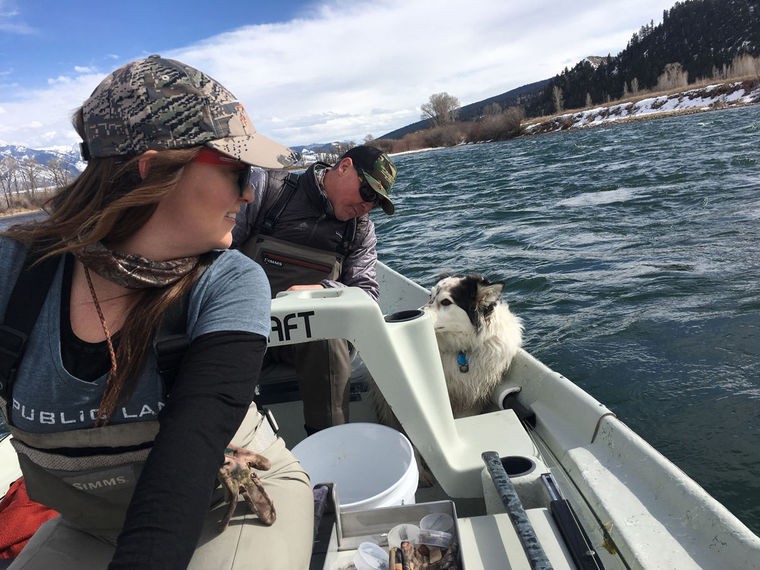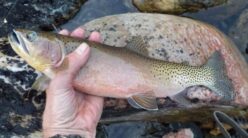The above average rain and snow that Eastern Idaho received this year will be a game changer for anglers.
“This year is unusual,” said Dave Heib, manager of the Three Rivers Ranch fly shop in Driggs. “I’ve lived here 10 years. I’ve not seen it like this.”
Heib pointed to the mountains, where the snowpack is among the largest in 20 years.
“We have so much dense snow that will melt,” Heib said. “The water is coming.”
Snow pack translates into run-off, fast flowing water that looks like chocolate milk because of all the dirt and silt it carries downstream.
Although run-off happens every year, this year’s will likely be longer than usual.
“Normally, well before the end of June runoff is done,” said Heib. “But this year, I hearken back to the days of ‘97 and ‘07 when my brother didn’t do his first guiding trip until Aug. 2.”
That’s a long time to not be fishing. But don’t lose all hope just yet.
Because rivers fed by run-off, like the Teton, will be too swift and dirty for fish to feed, early season anglers should look for spots that are not affected — and expect there to be plenty of fish.
“There are many, many places that may not be blown out,” Heib said. “You have a lot of streams that aren’t affected by other creeks dumping mud.”
Anglers should look for spring fed creeks and rivers, among which the Warm River is a prime example.
“Two of our guides that did a trip recently saw nine to 10 adult salmon flies, which is about 15 to 20 days early,” Heib said.
Other flies have been hatching early this year, especially the caddis fly — including the Olive, Brown, and even Mother’s Day caddis — so places that are fishing well will be fishing very well indeed.
Meanwhile, there’s a big, silver lining to the cloudy water — a much better late season.
“Once all this starts flushing big time, that moves all the silt out, it could help to make a wonderful May fly and PMD year,” explained Heib. “May flies and PMDs can’t live with the silt, they’ve got to have rocky free stone.”
May flies, being a key part of the trout diet, will make for prolific fly fishing once they begin hatching.
“May flies start fairly early and they go until it starts to snow,” Heib said. “This year might be good, but my prediction — next year will be a huge May fly year, which we have not had in six, seven, eight ears.”
More water also translates to another key ingredient for happy fish — cooler water.
“When the water table is higher, we will have a much cooler water temperature later in the season,” Heib explained. “With cooler water, you have a much higher chance of catching and releasing a fish that will survive.”
This means August and early September fishing may be better than years in the past.
“Over the past five to six years, once it comes to August the water temp has become so hot we have a high mortality rate, the fishing slows down,” Heib said. “If the water temperature becomes almost bath tub, there’s no amount of releasing a fish that isn’t dangerous for it.”
More water also means more places to fish.
“The snow pack will keep the small creeks fishing good late into the season,” said Justin Mehlhaff, a local guide who also manages the Three Rivers Ranch shop in Driggs. “It might affect where some of the fish spawn. Little creeks that fish couldn’t travel up may be able to travel up this year.”
Creek tributaries to the Teton include South Leigh Creek, Teton Creek, Fox Creek, Darby Creek and Pine Creek.
August being a ways off, the impatient angler may feel inclined to take a risk or two in pursuit of a hungry fish on the South Fork of the Snake.
“Early season on the South Fork is not for the faint of heart and not for anybody that doesn’t know what they’re doing,” Heib said. “That’s where most people die every year. … It’s highly recommend for travelers that want to take float trips early season—take a guide. I’d rather save my life than catch a fish.”
Those dangers are only amplified by the amount of water being let out of the Palisades Reservoir, which has matched springtime records.
“The Palisades Reservoir matched the ‘86 record with how much water was let out by the third week in March,” Heib said. “They are doing damage control, they know what’s coming.”
Any time of year on the South Fork can be dangerous.
“The hazards change with the water levels,” explained Mehlhaff. “What could have been hazardous at high levels at low levels will not be hazardous, and vice versa.”
One thing is certain, it will be a great summer.
“Most outfitters believe it will be the longest, greatest year we’ve had in the last 10 years,” said Heib. “We’re keeping our fingers crossed.”



